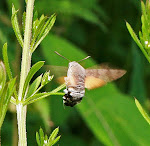
August 22, 2011:
Very warm calm weather led to a high degree of dragonfly activity at a small pool here today. A huge number of Black Darters could be seen engaged in a range of activities. At one point four tandem pairs were ovipositing in a damp patch no larger that a dinner plate. Other mating pairs were perched in the vegetation and mature males posed at vantage points by the water margin. However the immatures and females kept some distance away from the water's edge.

Mating pair of Black Darters]



[Black Darter males, above]

[Black Darter, female]
Many Emeralds were also present, most of them males.


[Emerald Damselfly, male, both above]
At least one Brown Hawker was flying as well as a Southern Hawker which lived up to its reputation of buzzing human intruders. An Emperor put in a brief appearance and Commom Blues accounted for the other damselfly species present.lak
.jpg)














































